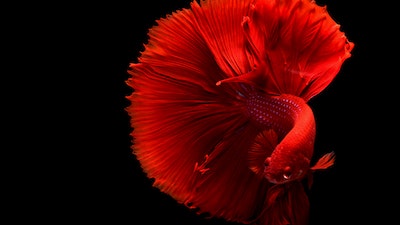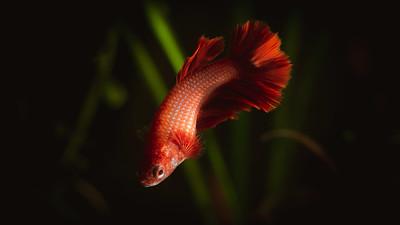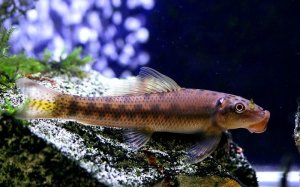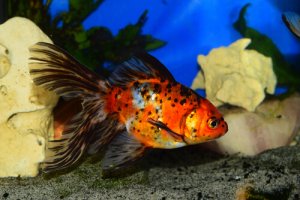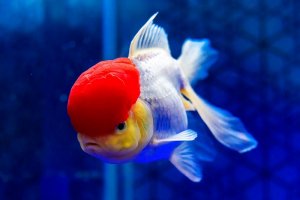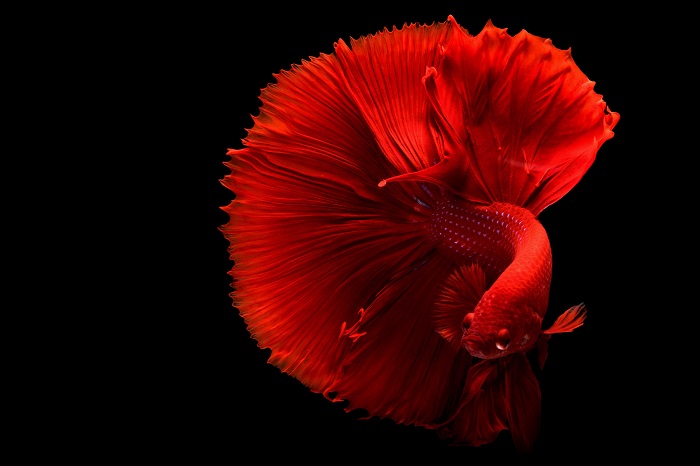
The Red Betta Fish, or Siamese Fighting Fish as many of us know it, is an intricate and extraordinarily beautiful fish that is intelligent and can be challenging to keep, but so rewarding. Once you have fallen in love with this freshwater fish species there is absolutely no going back, and I, myself am particularly fond of them. So in this scare Guide, I am going to be sharing so many interesting facts about the Red betta fish that you may not have known.
Breed Overview
| Origin | The Red Betta Fish was first Domesticated in Thailand and originated from Southeast Asia. |
| Lifespan | The betta Fish has a short lifespan of around 2-5 years. |
| Size | They are quite small, around 6 -8 CN, (2.4-3.2 Inches), usually not reaching more than 3 inches. |
| Colour | The red betta Fish comes in brownish Red, Dark red, or Scarlet red Color Variations. |
| Food | Carnivorous |
| Tank Size | A tank of around 3 -5 gallons is ideal, however, you can go as small as 1 gallon per fish. |
| Temperament | Bettas in General are aggressive towards males of the same species, but in general they are quite social. |
| Water Type | Freshwater |
| Water Temperature | Water temperatures between 24-28 degrees Celsius, or (75-82 Fahrenheit). |
| Water pH | They enjoy a neutral pH of 7.0 or higher. |
| Care Level | Intermediate to Advanced. |
Species Information
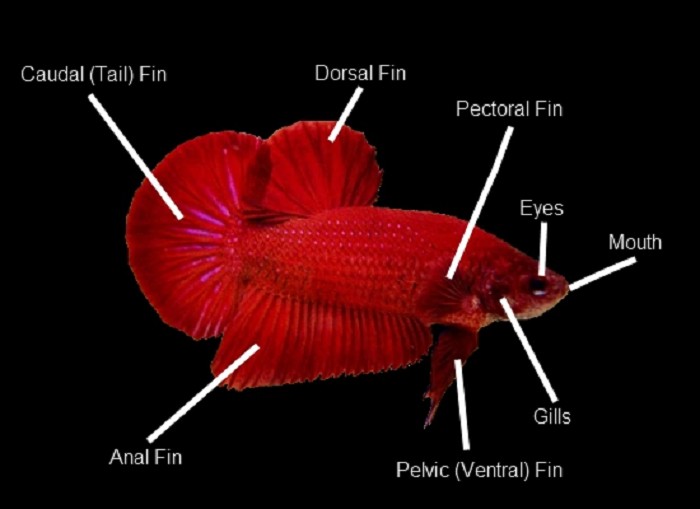
The Red Betta is a species called the Betta Splendens, or Siamese Fighting Fish that is native to South East Asia, originating in Thailand as a domesticated fish 1000 years ago.
Betta Fish have an extremely diverse and very colorful form and structure in general and they are low maintenance to keep.
They were initially bred as Fighting fish for gambling purposes, because of their aggression towards each other in confined spaces.
Males are extremely aggressive towards each other, and territorial, and should never be kept together. However females are more tolerant, should they have enough space.
Color Variations Of The Red Betta Fish
Betta Fish in general come in Many Colors, Blue, Orange, Red, Gold, and then also rare colors such as white and purple. They may have a Solid body color, lighter fins, or marbled colors, some may even have more than one color.
However, with regards to the Red Betta Fish here are your color options;
- Brownish red
- Dark Deep red
- Super red
- Scarlet red
- Red Bi-Color
- Marbled red
In some cases betta fish may change colors which can be due to age, illness or stress and results in a more marbled coloration, you might need to check your water condition and tank temperatures if you do notice faded or marbled color changes.
Finnage Types
Besides the different color Variations in betta Fish, many breeders have similarly developed different Finnage and scale variations in these fish, which you may also find in the Red betta Fish;
- Veiltail – The Most Common Tail type that has extended length and caudal fin rays only split once.
- Crowntail – Extended Fin rays and the tail resembles a crown.
- Combtail – A less extended version of the Crown Tail.
- Halfmoon – There is a “D” shaped Caudal fin with 180-degree edges on the tail that are more straight and defined.
- Rosetail – The Finnage is so much that it overlaps and resembles a rose.
- Feather Tail – Similar to the Rosetail with a rough appearance.
- Plakat – The Tail and Fins are short, which you find mostly in wild bettas.
- Elephant Ear – The Pectoral fins will be much larger than normal, and looks like elephant ears, usually white.
- Spade Tail – The Tail, or Caudal Fin has a wider base and narrower point, resembling a spade.
Red Betta Fish Size
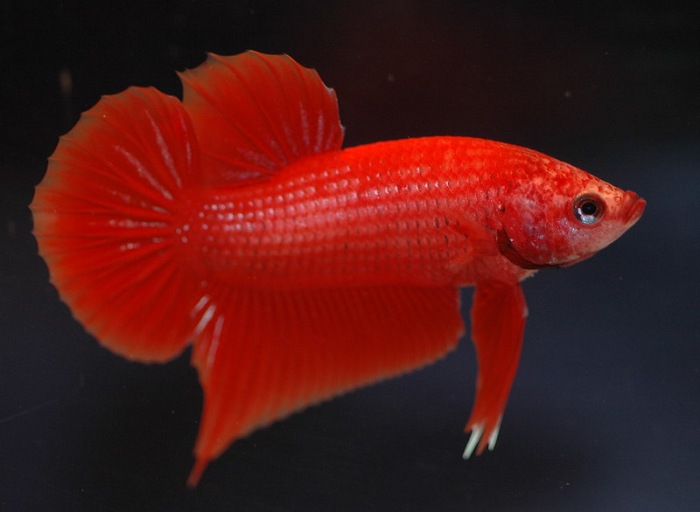
Most betta fish species except Giant species will grow to a length of around 6-8 cm (2.4 – 3.1 inches). There is much more to the Betta Fish Size that you can read up on in “How Big Do Betta Fish Get” in more detail. Though most beta Fish will not reach over 3 inches in size.
General Care
Betta Fish, in general, are popular Fresh Water fish that has an elegant and sophisticated demeanor with gorgeous vivid colors available that can be extremely eye-catching in any aquarium.
With proper information and care, they can be kept by beginners, as they are quite easy to keep. I would regard this as a fish species for a more knowledgeable beginner or experienced Aquarist. Betta Fish requires a more tropical climate, though they can survive in colder climates, and they are more suited to pH-neutral water.
As they are carnivores, you will need to invest in good quality high protein foods. But before we dive in further, let’s start off with setting up a proper Aquarium for your red Betta Fish;
1. Setting Up Your Tank
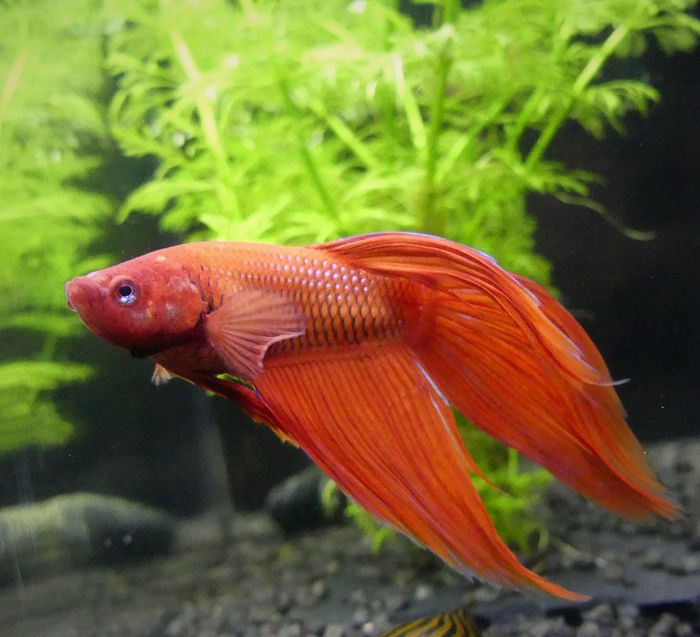
Choosing A Tank
You may have frequently seen betta fish displayed in small cups or bowls, and confined spaces within the tanks of pet traders, especially the males. Though they can survive in these small spaces, it is not ideal for them and they will live a longer and much happier life in a properly set up, larger tank.
There may be some debate, though a proper size tank for a Betta fish should be around 3-5 gallons. Still, if cleaned regularly you can get away with a 1 Gallon tank for a single betta Fish.
I must mention again that male betta fish are solitary and aggressive towards each other especially, though they can cohabitate with some species of fish and invertebrates, given that they are provided with enough of their own space and hiding places.
Unfortunately, this is a risk that you are taking as compatibility with other fish will rely mostly on the temperament of the individual Betta Fish that you have chosen, especially males, which are mostly chosen because they are much more appealing than females, which we will also get into further along.
Water Conditions
Betta Fish depend on more tropical climates usually ranging between 24 – 28 degrees Celsius (75 – 82 Degrees Fahrenheit), so you may need an Aquarium heater and thermometer. Though they can survive in much colder climates, it does tend to weaken their immune system which in turn, will make them more prone to disease.
Betta Fish do need a neutral pH of 7.0 or more, and they can tolerate low oxygen levels, though this in turn will also make them more susceptible to disease.
You will need to be careful in the selection of a mechanical filter as betta fish enjoy still water rather than a current, however, they do need a filter to keep water conditions at peak levels. You can likewise supplement with live Aquatic plants as they are an excellent natural form of water filtration and cleaning, as well as a source of oxygen.
Tank Set-Up And Decor
- Substrate
I want to start off with the substrate of your tank as a basis which is quite important for betta Fish in terms of what you choose. According to the “Japanese fighting Fish Organization”, gravel will be your best choice in terms of tank maintenance, and sand is the next best option, though you will need to rake it regularly as it can become compact. Marble should be avoided as it traps much debris and needs to be moved around for cleaning.
- Plants And Decor
Because the betta fish in general is such an inquisitive and intelligent fish species, it will require plenty of stimulation to prevent it from becoming bored and depressed, which may lead to weakness and illness.
Firstly, be mindful that ornaments and synthetic plants with rough textures and sharp edges will easily damage their very delicate fins. Betta fish do spend plenty of time concealing themselves so ornaments and plants that allow them to hide will be welcomed, and keep them feeling secure.
Here are a few types of decorations you can choose from;
- Plastic Plants
- Driftwood
- Rocks
- Caves
- Castles
- Other ornaments
Live Plants that they enjoy include;
- Floating Plants, such as the Amazon Frognit, Red Root Floaters, and water Sprites.
- You can float Indian Almond leaves in your tank, they help to reduce water hardness and have several other health benefits for Betta Fish.
- Stationary Plants such as Anubias, Java ferns, Marimo Moss Balls, betta Bulbs, Amazon Sword Plants, and Vallisneria can be placed inside the tank.
2. Choosing A Healthy Red Betta Fish
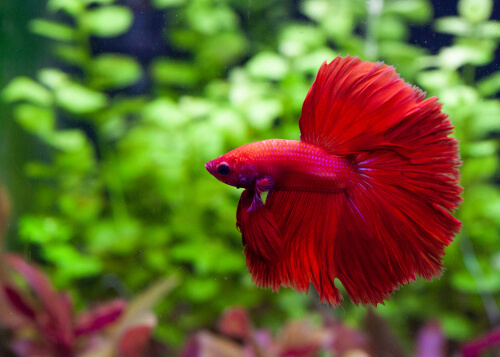
When selecting where to purchase your red Betta Fish you may have three choices; a Pet Store, Breeder, or Online. You must choose a healthy fish that was raised in a clean, and healthy environment, so make sure that you trust the source of your new Fish.
From WikiHow I have found these tips to help you select a healthy fish;
- Size – You may want to opt for a younger or juvenile Betta fish that already has an established eating routine. Avoid older and baby betta Fish.
- Color – For Red betta Fish the color needs to be a bright Vibrant red or a deep and dark almost brownish red. Juveniles may have stripes, however, stripes in adult betta fish usually indicate illness.
- Fins – The Fins should not show any signs of wounds, spots, discoloration, or disease. They should be flowing and not ragged or clamped.
- Gills – Also take a glance at their gills, both gills should open and close easily at the same time, with no prominent red markings around them.
- Body – The Body should look healthy and streamlined. There should be no lumps, bumps scale sticking out, or white spots, and the belly should not be swollen.
- Eyes – Eyes on the Red betta Fish need to be a clear black color, with no white or pale discoloring.
3. Choosing A Male Or Female Red Betta Fish
A small matter to consider before purchasing your Red Betta Fish, you most likely have your heart set on a male, as most people do. Males are much more attractive than females when it comes to betta Fish, however, they are also much more aggressive. So if you are going to be keeping a single fish, a male will be perfect and also most appealing.
On the other hand, you could keep your male betta Fish with other tank mates, which we will also discuss further, or with females, however, this can be extremely risky as Male betta fish are territorial, aggressive, and usually solitary fish, that may or may not attack other fish, even females, depending on the individual fish, and its mood.
Females can also be aggressive, but not as much as males, and they tend to be more social. So if you want to keep other fish with your Red betta fish, I would rather settle for the female Betta fish, as she poses less of a risk.
Here are some differences between the male Red and Red female Betta Fish;
| Male Rose Petal Red Betta
|
Female Halfmoon Red Betta
|
| ●Males have very vibrant and vivid colors.
●Males have a much more elongated and elegant body and are flatter from side to side. ●Males generally have much longer and thicker fins and caudal fins. ●When males flare their “beard”, behind the gills it’s larger, and the flare is more flamboyant. ●Males are extremely aggressive and should only be placed with a female for mating. They are aggressive towards other males and can be towards other fish species. ●Males create bubble nests at the surface of the tank to protect eggs, with their saliva. |
●Females are not as colorful as males. They display vertical stripes on their body when they are ready to mate.
●Females have wider and shorter, stout bodies. ●Cuadal and ventral fins of the female are noticeably shorter and less thick. ●Females flare a much smaller “beard” and tilt their heads down rather. ●Females may be aggressive toward a single female but can be kept with a group of females, so as not to bully a singled-out female. ●Similarly in some cases females may also create a bubble nest at the surface of the tank. However, this is quite rare among female betta Fish. |
4. Placing Your Betta Fish In Its New Tank
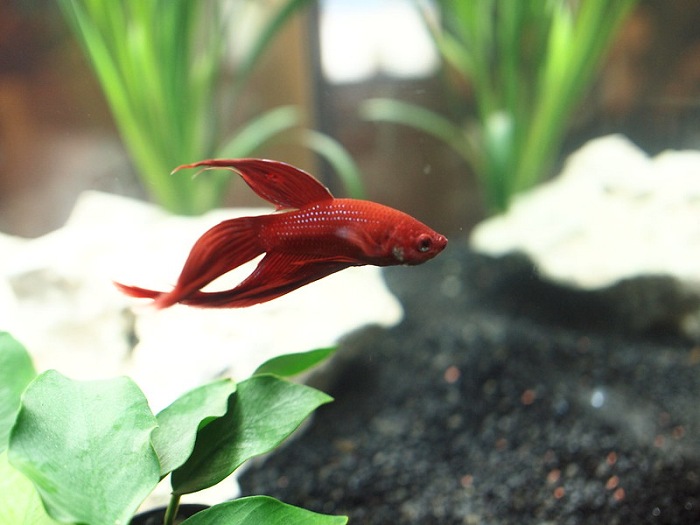
Before adding your new Betta fish to your Aquarium, the aquarium needs to be fully settled and cycled for at least 5 days to a week. You can add some additional water conditioners to relieve stress.
Did you know that betta Fish have a protective slime coat, which gets rubbed off when they are netted and handled? Thus you need to be extremely careful as they are more fragile at this point.
The best method to add a new fish to its new home is to leave the unopened bag floating in the new tank for 20 to 30 minutes for the fish to get used to the water temperatures and surroundings. Then they can remove a cup of water from the bag and replace it with water from the tank, doing so every 15 minutes for around an hour. Lastly, you can release your fish into the water, taking care not to empty the contents of the bag which could contain plenty of ammonia from waste, into the water.
Selecting Tank Mates
Selecting tank mates for red Betta fish, especially males can be quite tricky. As I have mentioned you can never house two males, a male, and a female, or two females of Betta fish together. You can try and house a group of female Betta fish together though.
As with tank mates of other species, most betta fish, even males can generally speaking get along with a few types of fish and invertebrates, just ensure that you have enough tank space and hiding places for your Betta fish.
Unfortunately, it is a risk that you are taking because how your new Betta fish is going to interact with other fish will depend entirely on the temperament of the individual fish.
When selecting tank mates to start with choose tropical and communal fish, that tend to shoal, and that are not territorial. Stay clear of fish that have long flowing fins and that have very bright coloring, as they are inviting to betta fish. Also, stay clear of predatory fish that may in turn nip at your Betta fish, and damage its fins or erode its slime coat.
Here is a List of some good choices in tank mates to keep with your Betta Fish;
- Tetras – They are peaceful and can be kept in larger groups.
- Loaches – Loaches are peaceful scavenger fish that feed off the bottom of the tank and can help to keep your tank clean. There are also many color variations available in this fish species.
- Malaysian Trumpet Snails are ideal for Betta fish. They are nocturnal and burrow in the substrate during the day. The snail is hardworking when it comes to helping to keep your tank clean.
- The Rasbora comes in quite a few colors that will enhance your tank. They are peaceful and fast, so your Betta could chase after them for some much-deserved enrichment. Opt for a school of at least six Rasboras.
- Corydoras – They are a type of catfish that are easygoing and also help to keep the tank clean. They are mainly bottom feeders.
5. Tank Maintenance
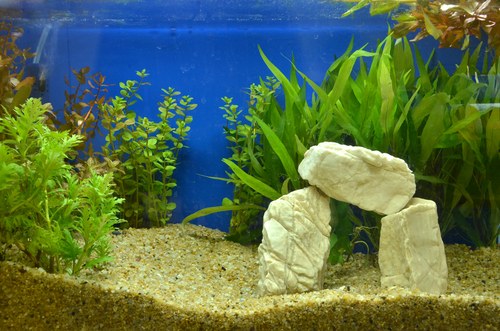
A dirty tank is unhealthy for any type of tropical or freshwater fish, and can easily cause them to become stressed or ill. To keep your Betta Fish healthy and happy weekly maintenance of the tank needs to be done.
You can follow these steps for easy maintenance;
- Remove at least 20 – 30 % of the water from your tank with a suction pipe from the bottom.
- Fill a separate container with the same amount of water, roughly the same temperature as the water in your tank.
- Add your water conditioner and test the pH and temperature of the water.
- When the water is at the right temperature and condition you can add it to your tank.
You can also invest in a tank vacuum, which will come in quite handy for cleaning.
If you need to do a more thorough cleaning of your tank you can follow these steps on WikiHow, they will explain more in-depth about cleaning your Betta fish tank.
6. Feeding
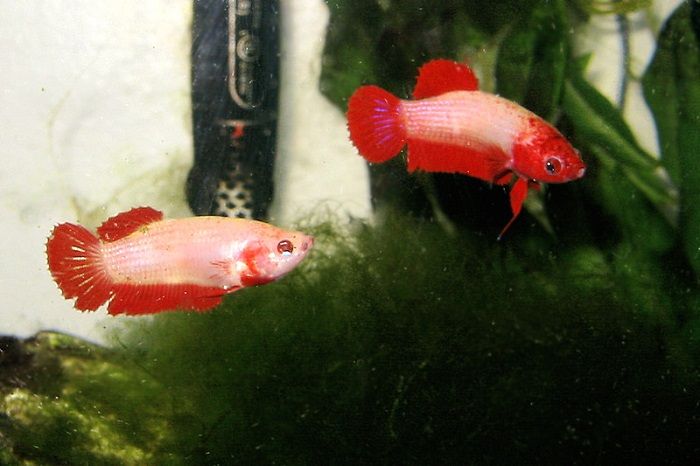
Betta fish are mostly carnivorous and in nature will feed on small crustaceans, larvae of aquatic insects, and zooplankton.
You can feed your betta fish good quality pellets or flakes sourced from a trusted pet store or breeder, or you can order it online. Betta Fish also enjoy live and frozen foods such as brine Shrimp, Bloodworms, and daphnia.
Keep in mind Betta fish have a short digestive tract which makes it difficult for them to digest most types of carbohydrates, which is usually included in most fish food as filler. A proper diet for your Betta fish should consist mostly of proteins.
How To Feed Your Betta Fish
Betta fish are quite greedy eaters and will easily overeat, which can lead to obesity, constipation, and swim bladder disease. It is advised to only feed your Betta fish once a day with an amount of food that it can finish within 3-5 minutes spending on the size and age of your Betta fish. Remove all leftover foods.
Did you know that Betta fish can go for weeks without eating? “ It is not uncommon for Betta fish to lose their appetite for a day or two,” and sometimes sit is also recommended for you to allow them a one-day fast every now and again.
Temperament And Personality
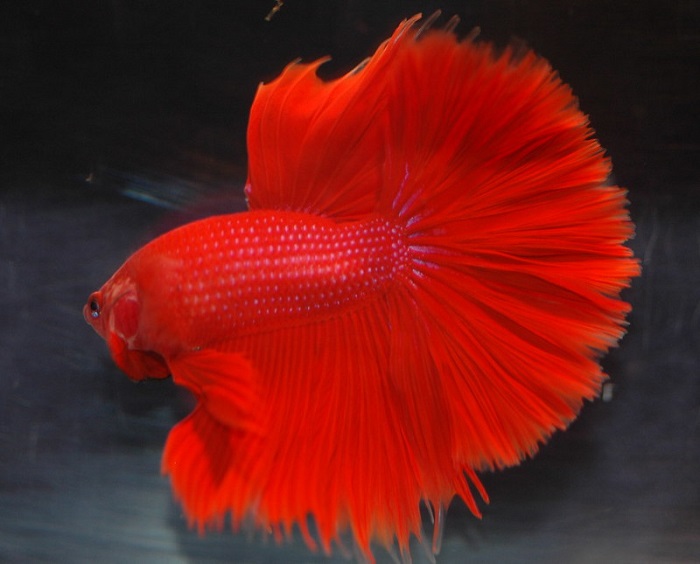
The Betta fish known as the Siamese Fighter fish is named as such for good reason. As I have mentioned in the beginning, the first Betta fish were initially bred for Fighting as a form of Gambling, similar to dog fighting. However today they are kept as pets for their gorgeous colors and elegance, along with their quite complex and socially interactive behavioral patterns.
Research has even indicated that Betta fish are capable of “associative learning”, which means they will eventually start to respond to certain stimuli consistently.
Betta Fish are aggressive in nature and can become extremely territorial over a certain space, rock, or plant in their tank. The females teen to be slightly less Aggressive.
Another interesting fact about Betta fish is that they will attempt to leap out of their tank, sometimes with success, thus their tank should always be kept covered.
Aggression In The Female Red Betta Fish
Female Red betta fish can be similarly aggressive as males, whoever usually much less intense and frequent. Females kept in groups will eventually develop an order of dominance, called a “pecking order”. In the case where two females are housed together, one will pick on the other weaker female. Males and females can likewise not be kept together.
The male betta fish becomes more placid during the bubble nesting phase when they want to start attracting a mate for breeding.
Common Health Issues
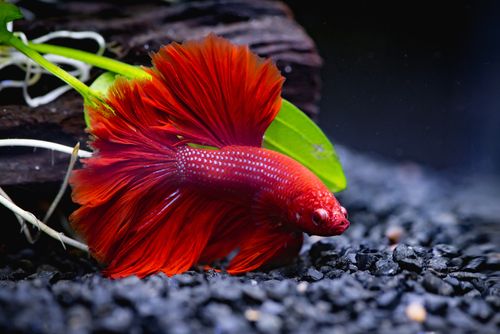
Betta fish need a clean tank, a good diet, and some Exercise to stay healthy and thriving. They can be chased around with a stick for a short period for exercise, or will sometimes chase after smaller fish.
One of the biggest issues I have found with Betta fish is when they are fed poor quality flakes or pellets, containing carbohydrate fillers, which can cause digestive issues and swim bladder. They also tend to overeat.
The five most common Illnesses found in Betta Fish are;
- White Spot – White Spot or Ich is a Parasite caused by poor tank conditions.
- Velvet – Sometimes called Gold Dust, or Rust disease because in ut cases the infected fish develop a dusty goldish brown color, because of a parasite.
- Fin Rot – Fin rot is a Bacterial infection that starts in the fins and spreads to the body. The disease is mainly caused when Betta fish are kept in communal tanks where other fish may nip at their fins.
- Dropsy – Dropsy is caused because of a compromised immune system, and will cause bloating, difficulty in breathing, and your Bettas scales to stick out.
- Physical Damage – Betta fish do have a slime coating to protect them. The fish or its fins can easily be damaged by handling, or sharp and rough textured plants and decor in the tank.
Most of these conditions can easily be treated with antibiotics and medication from your veterinarian. If your Betta fish has White Spot, you may need to quarantine it from other fish for a while as it is a contagious parasite.
Breeding Betta Fish
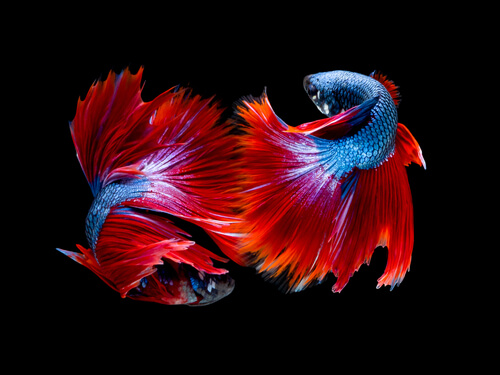
Betta Fish are quite tricky to breed because they are so aggressive and territorial, so it takes some time and effort. However, it is possible to breed Betta fish at home, and it can be very rewarding.
Breeding Betta fish is quite a long process and if you are serious about this endeavor I highly suggest that you read more in-depth about their breeding and mating habits in “How to Do Betta Fish Mate”, from our trusted source Your Aquarium Guide.
I am just going to touch on the basics for breeding Betta fish to give you an idea of where to start and what to expect.
So by now, I suspect that you most likely have a single male Betta fish with its tank mates, or maybe a few females. Males are kept separate from females in their own tank with tank mates, while females are kept in what we call a sorority of at least four or more females, as we have discussed previously, they have a pecking order.
Additionally, you will not need a specifically dedicated breeding tank;
1. Breeding Tank For Betta Fish
The breeding tank can be around 10 gallons with no substrate and a water depth of no more than five inches. It needs to be kept in a quiet place that does not get too much direct light.
The breeding tank must be filled with plenty of plants and hiding places, especially floating plants such as Indian Almond leaves for the Male to Create Bubble nests for the eggs. You also want high humidity in the tank so it can be covered with plastic wrap to create humidity.
2. Conditioning Your Male And Female Betta
It is important to get your male and female Betta fish in a healthy and well-fed condition before mating. Feed them a protein-rich meaty diet with plenty of bloodworms, tubifex worms, and daphnia especially. You can feed them four times a day, but only in small quantities.
3. Choosing A Breeding Pair
We have gone through some of the different color variations, and types of finnage in Betta fish, so if you would like to breed for a specific color or finnage, it is wise to choose a male and female of the same species. Betta fish should be around 6 to 12 months before they can breed, but not older than 14 months.
4. Adding Your Betta Fish To The Breeding Tank
As soon as the breeding tank is fully cycled, prepared with plants, and the humidity is right, you can add the FEMALE first. Allow her to roam and inspect the tank. The male can, later on, be placed in a divided section of the tank, or using one of those smaller dividers that you may have seen at the pet stores inside the tank.
They should inspect each other and become acquainted first. You will notice less aggressive swimming from both fish, the female will form vertical stripes on her body, and randomly shed eggs, whereas the male will start creating a bubble nest. You can now with careful supervision remove the divider.
5. Mating
The Male may wrap around the female to help her push out the eggs which he will then fertilize. After all the eggs have been laid and fertilized the male will chase the female away and carefully place the eggs in the bubble nest that he has created at the surface of the tank to protect the eggs.
The male uses his saliva to create small bubbles in which he places each egg. The female Betta Fish may also inspect the bubble nest beforehand to ensure that this is the right mate for her. Now you can remove the female from the breeding tank.
6. Egg And Hatchling Care
Believe it or not, the male essentially takes care of the eggs and the hatchlings, for a short time, around 3 to 6 weeks, until they become independent. Then the male needs to be removed as he can become aggressive towards the older fry. You can now feed the Vinegar Eels and Micro worms. After around two months when they start showing more aggression, they do need to be removed and placed in separate tanks, or rehomed.
To Conclude
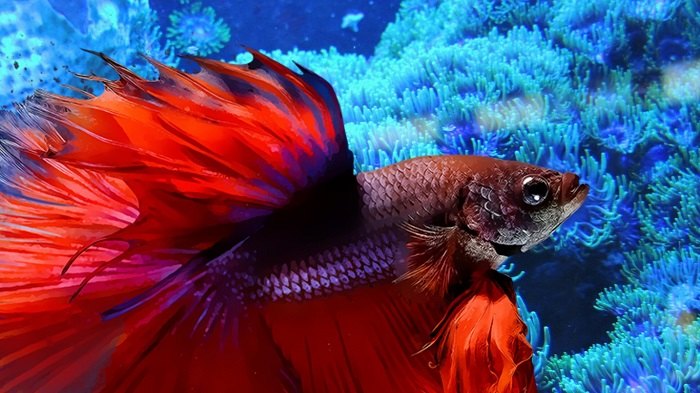
You may have seen betta fish in small bowls and pet stores and even advertised, and this is not a good practice. Betta fish do need a proper tank with plenty of plants and decorations to keep them stimulated. They have fragile flowing fins so opt for natural or silk plants rather than hard plastic, and safer decorations.
Betta fish should be interacted with as much as possible by you, and the tank needs to be placed in a spot where the fish can see you and get to know you. They tend to get bored fast, and then become depressed and ill. A few tank mates may give them some enrichment, however, they should be selected with care.


